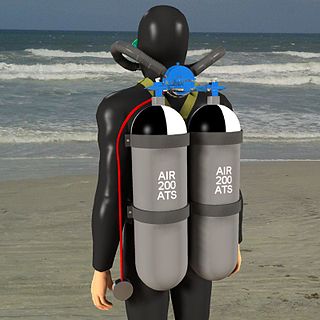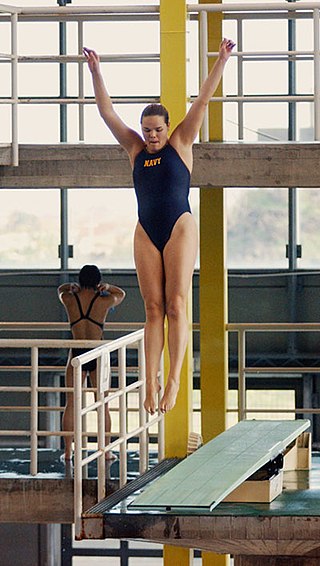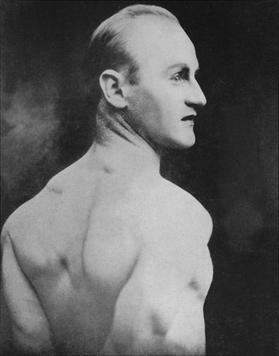Related Research Articles

Diving is the sport of jumping or falling into water from a platform or springboard, usually while performing acrobatics. Diving is an internationally recognized sport that is part of the Olympic Games. In addition, unstructured and non-competitive diving is a recreational pastime.
The timeline of underwater diving technology is a chronological list of notable events in the history of the development of underwater diving equipment. With the partial exception of breath-hold diving, the development of underwater diving capacity, scope, and popularity, has been closely linked to available technology, and the physiological constraints of the underwater environment.

Aqua-Lung was the first open-circuit, self-contained underwater breathing apparatus to achieve worldwide popularity and commercial success. This class of equipment is now commonly referred to as a twin-hose diving regulator, or demand valve. The Aqua-Lung was invented in France during the winter of 1942–1943 by two Frenchmen: engineer Émile Gagnan and Jacques Cousteau, who was a Naval Lieutenant. It allowed Cousteau and Gagnan to film and explore underwater more easily.

Technical diving is scuba diving that exceeds the agency-specified limits of recreational diving for non-professional purposes. Technical diving may expose the diver to hazards beyond those normally associated with recreational diving, and to a greater risk of serious injury or death. Risk may be reduced via appropriate skills, knowledge, and experience. Risk can also be managed by using suitable equipment and procedures. The skills may be developed through specialized training and experience. The equipment involves breathing gases other than air or standard nitrox mixtures, and multiple gas sources.

Deep diving is underwater diving to a depth beyond the norm accepted by the associated community. In some cases this is a prescribed limit established by an authority, while in others it is associated with a level of certification or training, and it may vary depending on whether the diving is recreational, technical or commercial. Nitrogen narcosis becomes a hazard below 30 metres (98 ft) and hypoxic breathing gas is required below 60 metres (200 ft) to lessen the risk of oxygen toxicity.
Sheck Exley was an American cave diver. He is widely regarded as one of the pioneers of cave diving, and he wrote two major books on the subject: Basic Cave Diving: A Blueprint for Survival and Caverns Measureless to Man. On February 6, 1974, Exley became the first chairman of the Cave Diving Section of the American National Speleological Society. During his career, he established many of the basic safety procedures used in cave and overhead diving today. Exley was also a pioneer of extreme deep scuba diving.

The British Sub-Aqua Club or BSAC has been recognised since 1954 by UK Sport as the national governing body of recreational diving in the United Kingdom.

A dive boat is a boat that recreational divers or professional scuba divers use to reach a dive site which they could not conveniently reach by swimming from the shore. Dive boats may be propelled by wind or muscle power, but are usually powered by internal combustion engines. Some features, like convenient access from the water, are common to all dive boats, while others depend on the specific application or region where they are used. The vessel may be extensively modified to make it fit for purpose, or may be used without much adaptation if it is already usable.

An atmospheric diving suit (ADS) is a small one-person articulated submersible which resembles a suit of armour, with elaborate pressure joints to allow articulation while maintaining an internal pressure of one atmosphere. An ADS can enable diving at depths of up to 2,300 feet (700 m) for many hours by eliminating the majority of significant physiological dangers associated with deep diving. The occupant of an ADS does not need to decompress, and there is no need for special breathing gas mixtures, so there is little danger of decompression sickness or nitrogen narcosis when the ADS is functioning properly. An ADS can permit less skilled swimmers to complete deep dives, albeit at the expense of dexterity.

A springboard or diving board is used for diving and is a board that is itself a spring, i.e. a linear flex-spring, of the cantilever type.

Canoe diving and Kayak diving are recreational diving where the divers paddle to a diving site in a canoe or kayak carrying all their gear in or on the boat to the place they want to dive. Canoe or kayak diving gives the diver independence from dive boat operators, while allowing dives at sites which are too far to comfortably swim, but are sufficiently sheltered.

Karel Soucek was a Czech professional stuntman living in Canada who went over Niagara Falls in a barrel in 1984. He lived in Hamilton, Ontario.

Friedrich Harald August Froboess was a German stunt diver, and high diver.

Shallow diving is an extreme sport, whereby enthusiasts attempt to dive from the greatest height into the shallowest depth of water, without sustaining injury. It is typically associated with traveling circuses along with the strongman, performing animals, clowns and other such attractions.

Helen Crlenkovich was one of the most successful athletes in America and the world on the three-meter springboard and the ten-meter platform. She was a Croatian American known to friends and family as "Klinky." Both of her parents were from Croatia: mother Anka Tomin was from Petrijevci, and father Adam from Banićevac near Cernik.

The history of underwater diving starts with freediving as a widespread means of hunting and gathering, both for food and other valuable resources such as pearls and coral. By classical Greek and Roman times commercial applications such as sponge diving and marine salvage were established. Military diving also has a long history, going back at least as far as the Peloponnesian War, with recreational and sporting applications being a recent development. Technological development in ambient pressure diving started with stone weights (skandalopetra) for fast descent. In the 16th and 17th centuries diving bells became functionally useful when a renewable supply of air could be provided to the diver at depth, and progressed to surface-supplied diving helmets—in effect miniature diving bells covering the diver's head and supplied with compressed air by manually operated pumps—which were improved by attaching a waterproof suit to the helmet and in the early 19th century became the standard diving dress.
Peter H Beveridge was a British diver who competed for England at the 1934 British Empire Games. He served as honorary secretary of the Highgate Diving Club, an early British diving club founded in 1928. After turning professional, he served as managing director of Aquatic Enterprises, Ltd., producing and performing in the first British water show, which toured seaside baths across England.

Albert Edward 'Bert' Powsey (1866–1956), known professionally as Professor Powsey, was a British high diver active between 1900 and 1941.

Frank Calladine Gadsby was a British competitive diver and swimmer. He was nicknamed "Peggy" on account of having only one leg, after having it amputated following an accident when aged four. He learnt to swim under the instruction of Professor Touhy, who also taught King George V.
References
- ↑ McWhirter, Norris (April 1985). Guinness Book of World Records, 1985. Bantam Books. ISBN 978-0-553-24805-0 . Retrieved 26 March 2023.
- ↑ Rushby, Kevin (22 April 2021). "10 of Britain's best outdoor pools in the countryside". The Guardian. Retrieved 26 March 2023.
- ↑ "PICTURES: Do you remember the Aqua Shows at Bournemouth Pier Approach Baths?". Bournemouth Echo. 2 August 2017. Retrieved 26 March 2023.